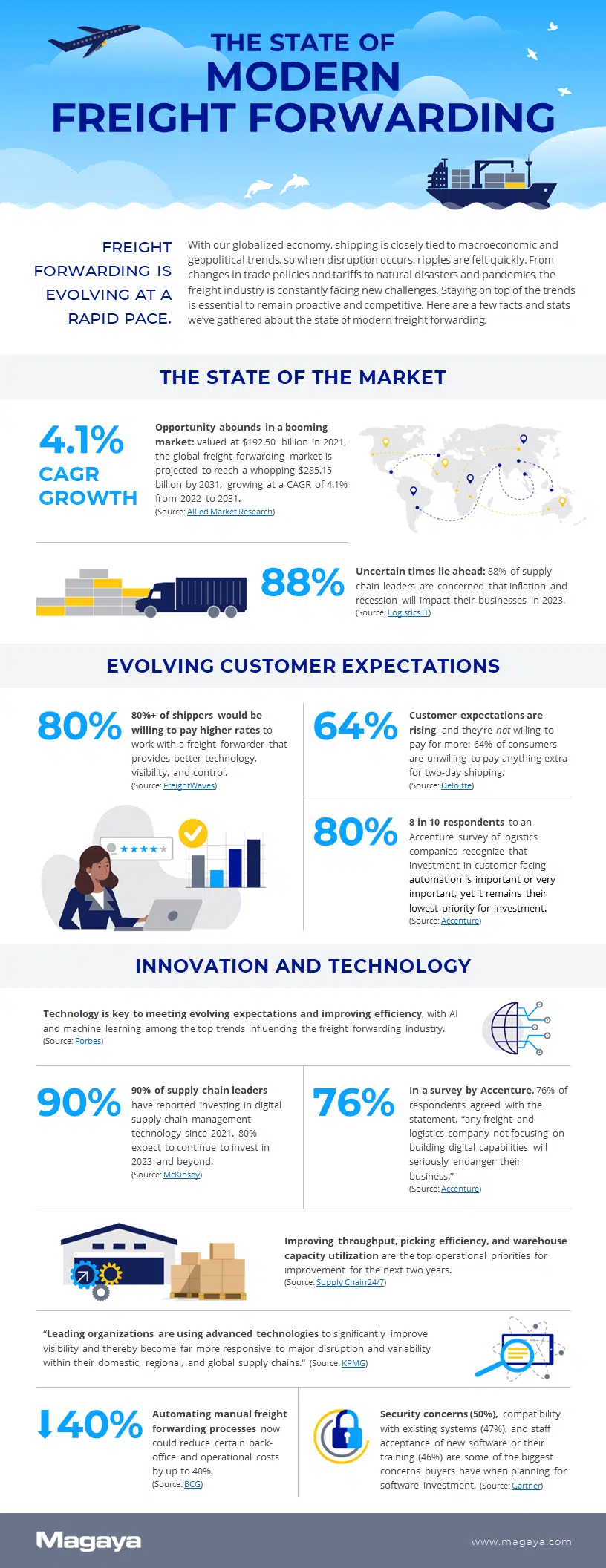Infographic: The State of Modern Freight Forwarding
Freight forwarding is evolving at a rapid pace. With our globalized economy, shipping is closely tied to macroeconomic and geopolitical trends, so ripples are felt quickly and often when disruption occurs. From changes in trade policies and tariffs to natural disasters and pandemics, the freight industry is constantly facing new challenges. Staying on top of the trends is essential to remain proactive and competitive. Here are a few facts and stats we’ve gathered about the state of modern freight forwarding.
Ready to digitize and modernize your freight forwarding operations?
See how Magaya can help.

The State of the Market
- Opportunity abounds in a booming market: valued at $192.50 billion in 2021, the global freight forwarding market is projected to reach a whopping $285.15 billion by 2031, growing at a CAGR of 4.1% from 2022 to 2031. (Source: Allied Market Research)
- Uncertain times lie ahead: 88% of supply chain leaders are concerned that inflation and recession will impact their businesses in 2023. (Source: Logistics IT)
Evolving Customer Expectations
- 80%+ of shippers would be willing to pay higher rates to work with a freight forwarder that provides better technology, visibility, and control. (Source: Freightwaves)
- Customer expectations are rising, and they’re not willing to pay for more: 64 percent of consumers are unwilling to pay anything extra for two-day shipping. (Source: Deloitte)
- 8 in 10 respondents to an Accenture survey of logistics companies recognize that investment in customer-facing automation is important or very important, yet it remains their lowest priority for investment. (Source: Accenture)
Innovation and Technology
- Technology is key to meeting evolving expectations and improving efficiency, with AI and machine learning among the top trends influencing the freight forwarding industry. (Source: Forbes)
- 90% of supply chain leaders have reported investing in digital supply chain management technology since 2021. 80% expect to continue to invest in 2023 and beyond. (Source: McKinsey)
- In a survey by Accenture, 76% of respondents agreed with the statement, “Any Freight and Logistics company not focusing on building digital capabilities will seriously endanger their business.” (Source: Accenture)
- Improving throughput, picking efficiency, and warehouse capacity utilization are the top operational priorities for improvement for the next two years. (Source: Supply Chain 24/7)
- “Leading organizations are using advanced technologies to significantly improve visibility and thereby become far more responsive to major disruption and variability within their domestic, regional, and global supply chains.“ (Source: KPMG)
- Automating manual freight forwarding processes now could reduce certain back-office and operational costs by up to 40%. (Source: BCG)
- Security concerns (50%), compatibility with existing systems (47%), and staff’s acceptance of new software or their training (46%) are some of the biggest concerns buyers have when planning for software investment. (Source: Gartner)
Ready to digitize and modernize your freight forwarding operations?
See how Magaya can help.